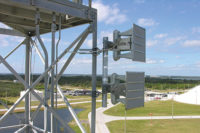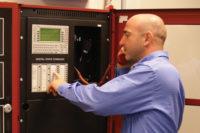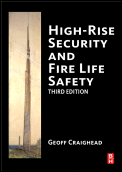Latest Fire Panels Meet Emergency Communications Requirements
Interest in emergency communications has driven the creation of the UL 2572 standard — and a new crop of fire panels now have the required capabilities.

ABOVE: Fire panels with UL 2572 approval support the ability for business users to speak through a microphone to give instructions to employees in the event of an emergency.

Safeguard Security and Communications has expanded its inspection business to include sprinkler inspection.

Dealers installing new fire systems should consider using speakers rather than horns in case the client may want to add ECS capability in the future.



Businesses and other organizations have taken an increased interest in emergency communications systems (ECSs) in the wake of several tragic shootings. And as the security industry considered the requirements for an optimal ECS, it was a logical choice to use fire panels to control the system. Fire panels already had considerable intelligence built into them and also had the ability to trigger audio and visual alerts.
Before fire panels could take on their new role, however, some modifications and new capabilities were needed. Those capabilities are defined in the latest versions of the NFPA 72 national fire alarm code and UL 2572 standard. Fire panels meeting those requirements are now on the market.
In this article we explore these requirements and the rationale behind them — as well as how to retrofit existing installations.
Emergency Communication Refined
The NFPA defines an ECS as “a system that indicates the existence of an emergency situation and communicates the necessary information to facilitate a response,” explains Susan Adam, director of marketing for Northford, Conn.-based equipment manufacturer Silent Knight.
Specific equipment that could be part of an ECS includes fire alarms, voice evacuation systems, mass notification systems, distributed recipient mass notification systems (DRMNSs) and fireman’s phones, explains Bryan McLane, vice president for National Training Center, a Las Vegas-based company that specializes in training about fire systems.
Whether or not facilities require an ECS is the decision of the local authority having jurisdiction (AHJ). But some clients may ask for emergency communications even when it is not required.
“It’s becoming more and more important for facilities to put it in,” comments Boyd Ferrin, general manager of the fire division for Ogden, Utah-based Mountain Alarm.
Mountain Alarm has installed emergency communications for educational, healthcare and government facilities, including some clients who had no regulatory requirement to do so.
Details about what an ECS system should comprise are up to the AHJ. But AHJs rely heavily on the NFPA 72 code in establishing their requirements.
Chapter 24 of the 2013 edition of NFPA 72 details capabilities for ECSs — and that information has driven the UL 2572 standard. Equipment used in ECSs is required to have UL 2572 approval. Equipment with that approval is now on the market from several manufacturers, including fire alarm panels and add-on devices that can be used to retrofit an existing installation without changing out the panel.
A good ECS starts with risk assessment — a process that identifies the types of emergencies a facility could potentially experience and the appropriate response to each type of emergency.
On a university campus, for example, one potential risk might be a random assailant — and the appropriate response might include alerting students and staff through a variety of means, including audible alerts through indoor and outdoor speakers, as well as text message and email notification.
Pre-recorded audio alerts may be appropriate for some types of emergencies. But for some other types of emergencies it may be appropriate for a person to provide detailed instructions by speaking into a microphone.
Ultimately risk analysis is the responsibility of the facility owner. But dealers can provide valuable insight and guidance to clients as they go through this process.
“The dealer becomes an advocate,” comments Ted Milburn, vice president for Long Branch, N.J.-based equipment manufacturer Cooper Notification Solutions by Eaton. The dealer’s job is to say “here are the potential things you could do,” Milburn advises.
UL 2572
In this section we explore some of the key requirements for UL 2572 approval and what manufacturers have done to their products to meet those requirements. Anyone planning an ECS installation should check the NFPA code for full requirements.
Signal prioritization. One critical requirement for fire panels that will support ECS functionality is to provide the ability for non-fire alerts to take precedence over fire alerts.
“What panel manufacturers had to do was to make the fire alarm panel flexible enough so that fire alarm signaling was maybe not the most critical element,” observes Milburn.
Support for non-fire strobe. Another UL 2572 requirement is to have a separate strobe for non-fire alerts. To meet that requirement, fire panels must have an additional output to trigger the additional strobe.
Speaker support. Unlike traditional fire systems that use horns for audio output, ECSs use speakers. When used for emergency communications, the speakers deliver pre-programmed and live voice alerts. When used for a fire alarm, the speakers provide the same type of audio alerts that horns traditionally have provided.
RCU support. Support for a remote command unit (RCU), also known as a local operator console (LOC), is another ECS requirement. An RCU is a device that gives end users full control of the ECS and is designed for installation in a different location than the main control panel. The idea behind the RCU is to give clients an alternative means of controlling the system if, for example, a gunman takes over the area where the main control is housed.
DRMNS support. Another piece of equipment that is often part of an ECS is a DRMNS. As Adam explains, a DRMNS is designed to communicate to many recipients in different ways. The three main ways are via texting, email and telephone, she says.
Adam notes that a DRMNS also can be used to send messages to an LED display. Such displays may be required or recommended in certain facilities.
“The fire system can trigger the DRMNS,” Adam explains. Some fire panels now have dedicated buttons that are designed to be pushed in the event of various types of emergencies, each of which can trigger the DRMNS to send a specific message using pre-established methods.
In the future Milburn envisions DRMNS capability being built into fire alarm panels. “We’re already seeing that to some degree — the convergence of different technologies into one,” Milburn comments.
It’s important to note that fire panels are not the only type of device that can be used to control an ECS. Another option is to use a paging system that has been designed to meet UL 2572 requirements — and some clients may prefer that option.
Future-Proofing & Retrofits
Some dealers, including Phoenix-based Safeguard Security and Communications and Seattle-based Washington Alarm, say emergency communications is a hard sell at this time.
“They’re starting to talk about it but they don’t have a budget,” observes Shannon Woodman, chief operations officer for Washington Alarm.
Safeguard CEO John Jennings echoes those comments. Emergency communications “hasn’t gained much traction yet,” he says.
He notes, for example, that recently there were 10 proposals for school funding on the ballot in his area — including some that were for security — but only two passed.
Even if clients aren’t ready to invest in ECS, however, it’s a good idea to educate them about their options, Ferrin advises. Some clients may want to add ECS capability in the future so make sure that any new fire systems are installed in a way that enables them to be easily upgraded in the future, Ferrin says. He notes, for example, that Mountain Alarm encourages clients purchasing new fire systems to use speakers rather than horns.
Another situation that dealers may encounter is the client who wants to add ECS capability to existing fire systems and may want to minimize the amount of new equipment they have to buy.
To meet the needs of these clients, some manufacturers offer what Adam calls “sidecars,” which are add-on devices that connect to existing fire panels to add functionality required for an ECS such as the ability to allow other types of alerts to take priority over fire alarms.
Sprinkler Inspection Offers New Revenue Stream
The fire alarm business is so code-driven that dealers may feel there are few opportunities to boost revenues. But one dealer that has found a way to give its fire business a boost is Phoenix-based Safeguard Security and Communications.
The company has seen a 20 percent increase in its inspection business because in addition to inspecting fire systems it now also inspects sprinkler systems, stove hoods, fire extinguishers and exit lights.
“Most companies want to deal with one company for monitoring, installation and repairs for sprinkler systems and fire alarms,” says Safeguard CEO John Jennings.
To get the right start in the sprinkler inspection business, Safeguard hired someone who had experience in that area and, as Jennings explains, the company “built a division around him.”
Three years later that division is doing close to $2 million in annual sales.
The person that Safeguard initially hired brought in some other people with experience in sprinkler inspection. Additionally several of Safeguard’s alarm technicians have gotten required certifications.
“We’re going back to our existing client base and telling them we now offer this,” Jennings observes. As a result, he says “there has been a tremendous upswing for us.”
Safeguard generally tries to sign up sprinkler inspection customers so that they pay a monthly fee for the service rather than paying annually.
That approach lets customers build inspection costs into their budget and as Jennings notes, “They’re paying monthly already for monitoring service.”
Looking for a reprint of this article?
From high-res PDFs to custom plaques, order your copy today!











